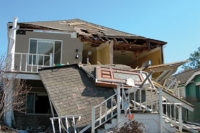Three Key Questions About Green Roofing




Recently, I was asked to participate in an online Q&A session about sustainable roofing. The questions I received were outstanding, so I thought every Roofing Contractor reader could benefit from a brief recap of the session, which is available free of charge in the “test drive” section of my course titled “Commercial Roofing Boot Camp.” To view it, just log on after clicking this link: http://bit.ly/roofingtest.
Q. When I talk to building owners and architects who are looking for LEED certification, the only thing they want to know about the roof is whether or not it’s white because white roofs get a LEED credit. Isn’t this a shortsighted way to design and specify a roof?
A. Yes, it is very shortsighted; and I’ll be the first to admit that changing the narrow focus on white roofs supported by the LEED heat island credit is very difficult. Probably the best tool available to improve the discussion about roof surface color is the RoofPoint program developed by the Center for Environmental Innovation in Roofing. RoofPoint recognizes the “greenness” of roofs using 23 different credits, and only one of these credits addresses roof surface color. And even the roof surface color credit in RoofPoint allows the use of darker roofs in the coldest climates and provides for other cool roof alternatives such as ballast. It’s a great program to educate building owners and help demonstrate that you can be a valuable expert on the best in sustainable roofing practice.
Q. How can I go about integrating green into my business?
A. I think it’s important to integrate green into your business in three basic ways. First, focus on one or two sustainable roofing strategies that could provide real value for your customers. As an example, if you re-roof a lot of warehouses, consider integrating daylighting (skylights) into your roofing proposals. There are many excellent design tools available to help you get started, and the payback is fast, especially if you can integrate the skylights into the lighting controls. For businesses with high hot water needs, such as laundries, car washes, etc., rooftop solar thermal can also be a profitable add-on to your next roofing project.
Next, look for ways to get your employees involved. Do you keep track of waste and scrap returned from jobsites, and do you have a plan to recycle or re-use them? Do you know how this year’s carbon footprint from your trucks and equipment compares to previous years, and do you have an incentive program to reduce fuel (carbon) usage? Finally, emphasize that worker safety is just as green as any other green practice. After all, green is fundamentally about people. Consider what you could do to help your community save energy and reduce waste. When you do this, it not only will help reinforce your in-house green programs, but it also will increase your company’s reputation as a sustainably-minded business.
Q. Are you concerned that some new “green” roofing products aren’t yet proven to be durable?
A. Yes, I do have concerns. My own roofing career started during the single-ply revolution of the 1970s and 1980s, and I know from hard experience how difficult it is to integrate new technologies into proven roofing practice. But I also recognize that time doesn’t stand still, and we need to find ways to use new green roofing products without exposing ourselves and our customers to potential risks. Here are three of my green performance tips:
1. Learn as much as you can about vapor retarders and how they need to be installed to actually work. Along with increased interest in cool roofs which tend to accumulate condensation and the use of air barriers to tighten up the building, we unfortunately may see premature roof failures due to long-term moisture damage — unless we work harder to keep the moisture out in the first place.
2. Given the significant increase in code-mandated insulation thicknesses, cover boards are almost mandatory to protect all that expensive R-value from damage. And the same goes for thermal barriers beneath the insulation, which can serve as a very effective platform for installing air barriers and vapor retarders.
3. With reductions in the VOC content of roof adhesives, cold weather application of fully adhered roofs is very, very tricky. So, invest in insulated “hot boxes” to store adhesives and keep them at a decent temperature on the roof. And make sure your crews are up to date on the latest technical bulletins about cold weather construction from your suppliers.
Recently, I was asked to participate in an online Q&A session about sustainable roofing. The questions I received were outstanding, so I thought every Roofing Contractor reader could benefit from a brief recap of the session, which is available free of charge in the “test drive” section of my course titled “Commercial Roofing Boot Camp.” To view it, just log on after clicking this link: http://bit.ly/roofingtest.
Q. When I talk to building owners and architects who are looking for LEED certification, the only thing they want to know about the roof is whether or not it’s white because white roofs get a LEED credit. Isn’t this a shortsighted way to design and specify a roof?
A. Yes, it is very shortsighted; and I’ll be the first to admit that changing the narrow focus on white roofs supported by the LEED heat island credit is very difficult. Probably the best tool available to improve the discussion about roof surface color is the RoofPoint program developed by the Center for Environmental Innovation in Roofing. RoofPoint recognizes the “greenness” of roofs using 23 different credits, and only one of these credits addresses roof surface color. And even the roof surface color credit in RoofPoint allows the use of darker roofs in the coldest climates and provides for other cool roof alternatives such as ballast. It’s a great program to educate building owners and help demonstrate that you can be a valuable expert on the best in sustainable roofing practice.
Q. How can I go about integrating green into my business?
A. I think it’s important to integrate green into your business in three basic ways. First, focus on one or two sustainable roofing strategies that could provide real value for your customers. As an example, if you re-roof a lot of warehouses, consider integrating daylighting (skylights) into your roofing proposals. There are many excellent design tools available to help you get started, and the payback is fast, especially if you can integrate the skylights into the lighting controls. For businesses with high hot water needs, such as laundries, car washes, etc., rooftop solar thermal can also be a profitable add-on to your next roofing project.
Next, look for ways to get your employees involved. Do you keep track of waste and scrap returned from jobsites, and do you have a plan to recycle or re-use them? Do you know how this year’s carbon footprint from your trucks and equipment compares to previous years, and do you have an incentive program to reduce fuel (carbon) usage? Finally, emphasize that worker safety is just as green as any other green practice. After all, green is fundamentally about people. Consider what you could do to help your community save energy and reduce waste. When you do this, it not only will help reinforce your in-house green programs, but it also will increase your company’s reputation as a sustainably-minded business.
Q. Are you concerned that some new “green” roofing products aren’t yet proven to be durable?
A. Yes, I do have concerns. My own roofing career started during the single-ply revolution of the 1970s and 1980s, and I know from hard experience how difficult it is to integrate new technologies into proven roofing practice. But I also recognize that time doesn’t stand still, and we need to find ways to use new green roofing products without exposing ourselves and our customers to potential risks. Here are three of my green performance tips:
1. Learn as much as you can about vapor retarders and how they need to be installed to actually work. Along with increased interest in cool roofs which tend to accumulate condensation and the use of air barriers to tighten up the building, we unfortunately may see premature roof failures due to long-term moisture damage — unless we work harder to keep the moisture out in the first place.
2. Given the significant increase in code-mandated insulation thicknesses, cover boards are almost mandatory to protect all that expensive R-value from damage. And the same goes for thermal barriers beneath the insulation, which can serve as a very effective platform for installing air barriers and vapor retarders.
3. With reductions in the VOC content of roof adhesives, cold weather application of fully adhered roofs is very, very tricky. So, invest in insulated “hot boxes” to store adhesives and keep them at a decent temperature on the roof. And make sure your crews are up to date on the latest technical bulletins about cold weather construction from your suppliers.
Looking for a reprint of this article?
From high-res PDFs to custom plaques, order your copy today!








